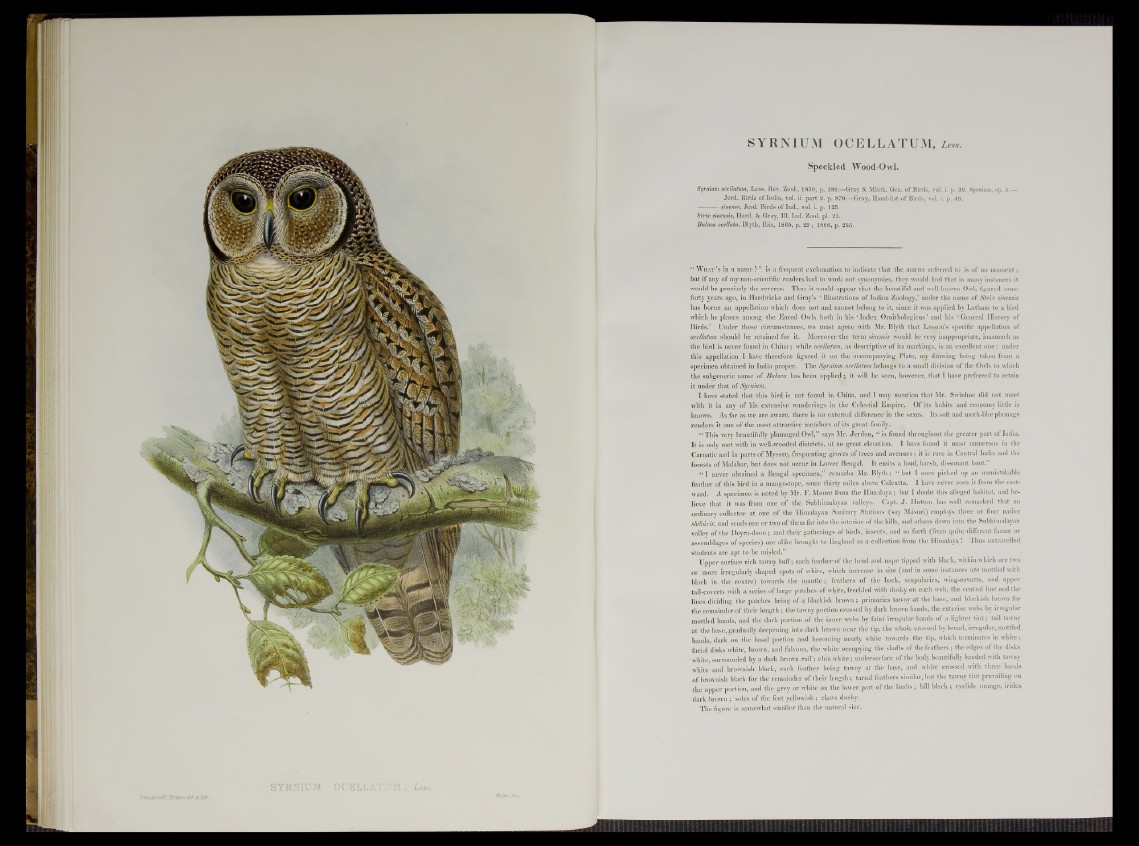
SYRNIUM 0 CE1LATUM. Uu.
J&ould toRCThchUr, deL et> liQv.
SYRNIUM OCELLATUM, Less.
Speckled Wood-Owl.
Syrnium ocellatum, Less. Rev. Zool., 1839, p. 289.—Gray & Mitch. Gen. of Birds, vol. i. p. 39, Syrnium, s p ..
Jerd. Birds of India, vol. ii. part 2. p. 870.—Gray, Hand-list of Birds, vol. i. p. 49.
sinense, Jerd. Birds of Ind., vol. i. p. 123.
Strix sinensis, Hard. & Gray, 111. Ind. Zool. pi. 21.
Bulaca ocellata, Blyth, Ibis, 1865, p. 29 ; 1866, p. 253.
“ W h a t ’s in a name?” is a frequent exclamation to indicate that the matter referred to is of no moment;
but if any of my non-scientific readers had to work out synonymies, they would find that in many instances it
would be precisely the reverse. Thus it would appear that the beautiful and well-known Owl, figured some
forty years ago, in Hardwicke and Gray’s ‘ Illustrations of Indian Zoology,’ under the name of Striic sinensis
has borne an appellation which does not and cannot belong to it, since it was applied by Latham to a bird
which he places among the Eared Owls both in his ‘ Index Ornithologicus ’ and his ‘ General History of
Birds.’ Under these circumstances, we must agree with Mr. Blyth that Lesson’s specific appellation of
ocellatum should be retained for it. Moreover the term sinensis would be very inappropriate, inasmuch as
the bird is never found in China; while ocellatum, as descriptive of its markings, is an excellent one: under
this appellation I have therefore figured it on the accompanying Plate, my drawing being taken from a
specimen obtained in India proper. The Syrnium ocellatum belongs to a small division of the Owls to which
the subgeneric name of Bulaca has been applied ; it will be seen, however, that I have preferred to retain
it under that of Syrnium.
I have stated that this bird is not found in China, and I may mention that Mr. Swinhoe did not meet
with it in any of his extensive wanderings in the Celestial Empire. Of its habits and economy little is
known. As far as we are aware, there is no external difference in the sexes. Its soft and moth-like plumage
renders it one of the most attractive members of its great family.
“ This very beautifully plumaged Owl,” says Mr. Jerdon, “ is found throughout the greater part of India.
It is only met with in well-wooded districts, at no great elevation. I have found it most numerous in the
Carnatic and in parts of Mysore, frequenting groves of trees and avenues; it is rare in Central India and the
forests of Malabar, but does not occur iu Lower Bengal. It emits a loud, harsh, dissonant hoot.”
“ I never obtained a Bengal specimen,” remarks Mr. Blyth; “ but I once picked up an unmistakable
feather of this bird in a mango-tope, some thirty miles above Calcutta. I have never seen it from the eastward.
A specimen is noted by Mr. F. Moore from the Himalaya; but I doubt this alleged habitat, and believe
that it was from one of the Subhimalayan valleys. Capt. J. Hutton has well remarked that an
ordinary collector at one of the Himalayan Sanitary Stations (say Masuri) employs three or four native
shikaris, and sends one or two of them far into the interior of the hills, and others down into the Subhimalayan
valley of the Deyra-doon; and their gatherings of birds, insects, and so forth (from quite different faunae or
assemblages of species) are alike brought to England as a collection from the Himalaya! Thus untravelled
students are apt to be misled.”
Upper surface rich tawny buff; each feather of the head and nape tipped with black, within which are two
or more irregularly shaped spots of white, which increase in size (and in some instances are mottled with
black in the centre) towards the mantle; feathers of the back, scapularies, wing-coverts, and upper
tail-coverts with a series of large patches of white, freckled with dusky on each web, the central line and the
lines dividing the patches being of a blackish brown ; primaries tawny at the base, and blackish browu for
the remainder of their length ; the tawny portion crossed by dark brown bands, the exterior webs by irregular
mottled bands, and the dark portion of the inner webs by faint irregular bands of a lighter tint; tail tawny
at the base, gradually deepening into dark brown near the tip, the whole crossed by broad, irregular, mottled
bands, dark on the basal portion and becoming nearly white towards the tip, which terminates in white;
facial disks white, brown, and fulvous, the white occupying the shafts of the feathers; the edges of the disks
white, surrounded by a dark brown ruff; chin white; undersurface of the body beautifully banded with tawny
white and brownish black, each feather being tawny at the base, and white crossed with three bands
of brownish black for the remainder of their length; tarsal feathers similar, but the tawny tint prevailing on
the upper portion, and the grey or white on the lower part of the limbs ; bill black ; eyelids orange, irides
dark brown ; soles of the feet yellowish; claws dusky.
The figure is somewhat smaller than the natural size.